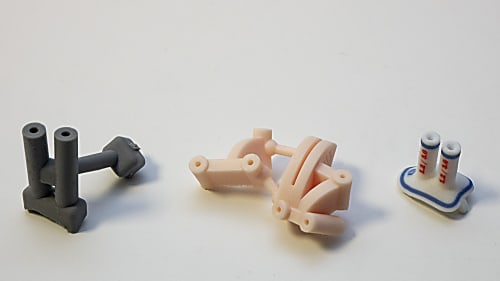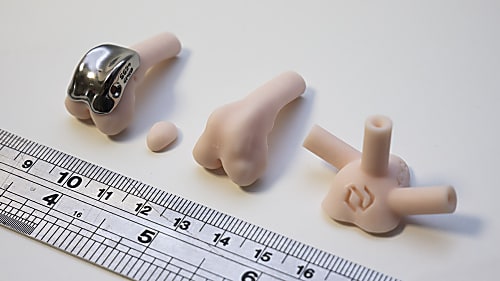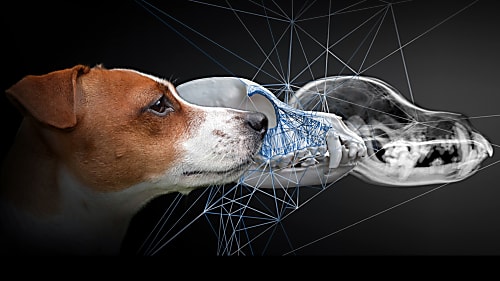The Revolution of Surgical Guides: 3 Case Studies Worth Reading
The application of 3D-printed surgical guides in veterinary medicine has brought about a pioneering change: here we present 3 very illustrative examples.
3D Printed vs. Traditional Implants: Advantages, Challenges, and Innovative Solutions in Veterinary Care
While traditional implants have long been a reliable solution for various medical issues, 3D technology offers benefits that can significantly enhance the efficiency of surgical procedures and the recovery process for patients.
This article provides a detailed overview of how 3D-printed implants differ from standard implants, the advantages they offer, and the challenges faced when using them in veterinary practice.
Advantages of 3D-Printed Implants (3DI)
Areas for Improvement
A Unique Solution Provided by 3D Technology When Traditional Implants Are “No Longer Enough”
A case study published in 20221 reported on a two-year-old Pomeranian dog experiencing severe issues 16 months after receiving a hip prosthesis.
Follow-up examinations revealed significant bone loss and medialization of the acetabular wall, which practically affected the dog's free movement.
Due to the patient’s small size, anatomical changes, and severe bone problems, traditional solutions were not feasible.
Instead, a custom 3D-printed titanium acetabular cage was created and implanted.
Two weeks post-surgery, almost completely normal limb functions were observed in the dog, and three years later, stable implant positioning and bone integration confirmed the success of the procedure.
Not Just Animals: 3D-Printed Implants Represent a Huge Leap Forward in Human Cases Too
Treating a failed ankle arthroplasty is a particularly challenging area; these cases are often addressed with TTC arthrodesis (fusion), which involves the fusion of the tibia, talus, and calcaneus using donor bone.
The problem is that these complex reconstructions often do not heal properly.
An example of this is a case study published in 20202, which details the story of a 65-year-old man.
In his case, ankle joint replacement was unsuccessful, and bone erosion and collapse were observed.
The solution was ultimately a 3D-printed titanium implant, which provided structural support to the affected area and facilitated bone integration, perfectly fitting the bones thanks to careful design.
Our Goal Is to Offer Modern Solutions in Veterinary Medicine
The continuous development of modern medicine and veterinary practice leads to new and innovative solutions, one of the most outstanding being the application of 3D printing technology in the field of implants.
LimesVet is committed to providing the most advanced technologies in veterinary care.
Our product range includes the latest 3D-printed implants, prostheses, and surgical guides, contributing to more efficient and safer surgical procedures.
References:
1A. Kang, H. Lee, Y. Roh, D. Kim, S. Jeong, J. Jeong (2022). Case report: Three-dimensionally printed patient-specific acetabular cage for revision surgery of aseptic loosening in a dog with micro total hip replacement. Frontiers in Veterinary Science. https://www.frontiersin.org/journals/veterinary-science/articles/10.3389/fvets.2022.915639/full
2R.J. Kadakia, N.B. Allen, A.E. Hanselman, S.B. Adams (2020). Clinical applications of custom 3D printed implants in complex lower extremity reconstruction. 3D Printing in Medicine. https://threedmedprint.biomedcentral.com/articles/10.1186/s41205-020-00083-4

The application of 3D-printed surgical guides in veterinary medicine has brought about a pioneering change: here we present 3 very illustrative examples.

One of the most frequent orthopaedic deformation in small dogs is the dislocation of the patella. Patellar luxation is often a congenital, inherited disorder but it can also be caused by a trauma or an accident. With the help of 3D design and printing, we have created an implant which is considered exceptional worldwide. It is uniquely designed and manufactured for the femur of the given animal. We deliver this product together with anatomical models and surgical drilling guides.

Today it is obvious that the appearance of 3D technology in the field of medicine opens new horizons for medical professionals in treating diseases. Currently we are just getting to know the advantages of this technology. However, thanks to the rapid development in this field, the question arises as to how to integrate all these achievements into the daily healing practice.
Patient-specific surgical equipment
Personalized implants
Patient-specific surgical equipment
Diverse anatomical visualization